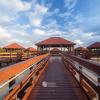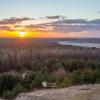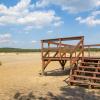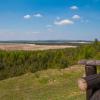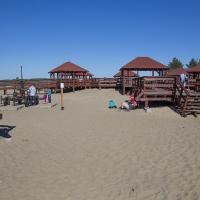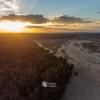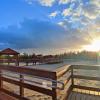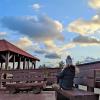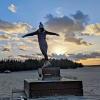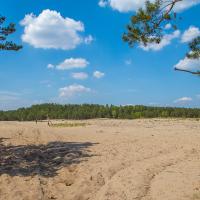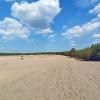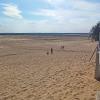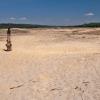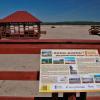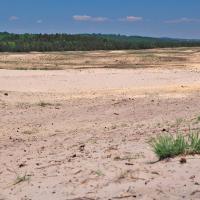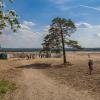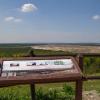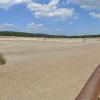Błędowska Desert
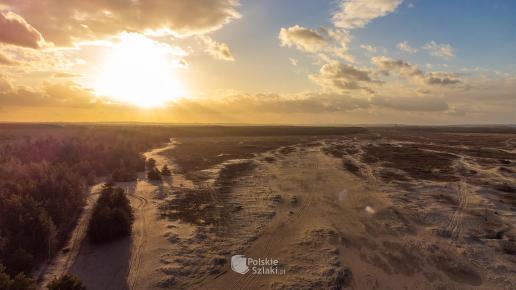
The Błędów Desert, called the Polish Sahara, is an unusual, unique tourist attraction stretching across themagnificent Kraków-Częstochowa Jura, between Klucze, Chechło and Błędów, on the border of Małopolska and Śląskie Voivodeship. This place attracts tourists from a wide area and it is not surprising, because this area is the largest area of open inland sands in Europe and although as a result of afforestation in the 1960s, it has grown quite strongly over the last decades and there have not been many open sand patches, it has been heavily weeded in recent years and is now extremely interesting again. Open sand with dunes, with only low desert vegetation create an amazing scenery, clearly visible from several convenient viewpoints, which I write about below.
Interestingly, only 100 years ago you could observe the phenomenon of a fatamorgan here! Today it is not so wild, there are a lot of viewing platforms, information boards, but I am sure that you will like it here very much. For the last several years, we have visited the Błędowska Desert several times and now it looks great. Be sure to visit this wonderful and mysterious place! You won't find a similar one in a wide area. Below you will find a lot of practical information and interesting facts about the Błędowska Desert!
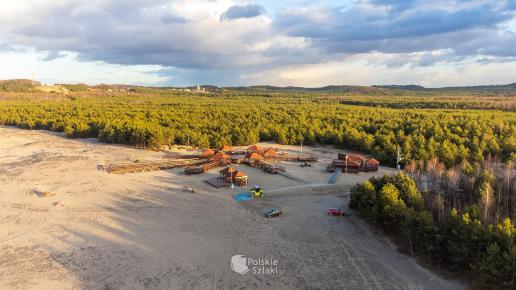
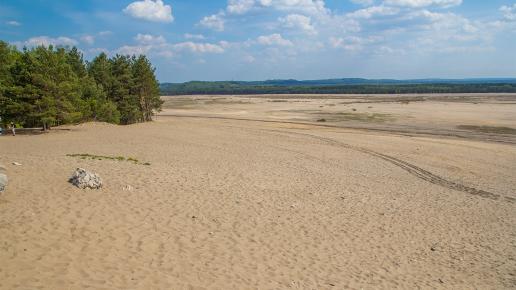
Viewpoints in the Błędowska Desert
Several convenient viewpoints have been created in the Błędowska Desert, which allow you to enjoy the extraordinary beauty of this place. This view is unique, because the Desert is a really large area of discovered sands among forests, so it is difficult to look for an equally wonderful attraction of this type throughout Poland! The most popular and phenomenal viewpoints in the Błędowska Desert are three. Two of them are located in Klucze, and one in Chechle.
Czubatka
The oldest but still very popular vantage point on the Błędowska Desert is Czubatka Mountain (382 m above sea level) located in Klucze. This is the best, because the most extensive viewpoint on the "Polish Sahara". It is located high above the sands and additionally gives great views of the sunsets, which we have recently even checked ourselves🙂 There is a large, free parking lot, benches, a picnic shed and information boards. Under the yellow Desert Trail parking lot, you can descend to the sands through the forest, about 1 km of a pleasant walk. You will feel really like in the desert, it is beautiful and you can walk this trail through the entire width of the Desert all the way to Błędów. You will meet a lot of information boards along the way.
Wind Rose
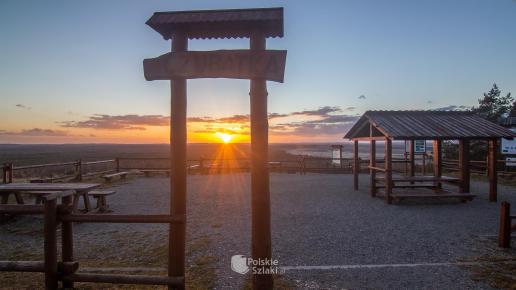
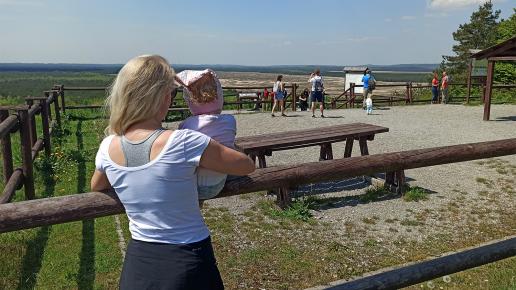
The latest vantage point in the Błędowska Desert and currently, in my opinion, the most interesting is the Rose of the Winds, also in Klucze. It is a beautiful, wooden viewing platform with an interesting shape, from which the name of the object derives. The Wind Rose is adapted for prams - for children and people with disabilities. It allows you to admire the discovered sands of the Polish Sahara and enter them, because the arms of the structure descend directly onto the sands. Every September, a family picnic combined with military attractions takes place at the Rose of the Winds as part of the Juromania- an outdoor event of the Eagle's Nests Trail. You can get here from Bolesławska Street in Klucze, currently an asphalt road leads to the platform itself. We pass a few car parks along the way. The wind rose is available for wheelchairs, and the structure conceals peculiar picnic shelters with benches and information boards. The construction also included military cannons, which refers to the fact that the Desert was and partly still is a military area.
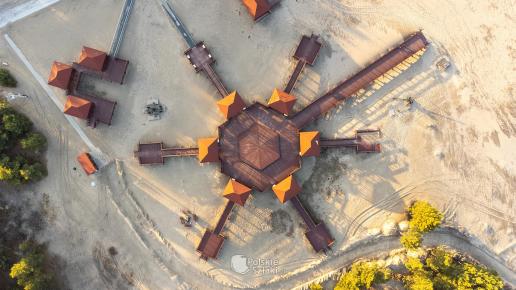
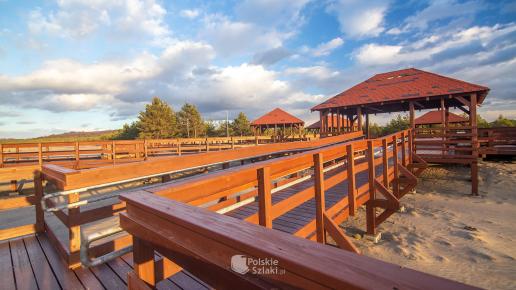
Dąbrówka
The third vantage point on the Błędowska Desert is Dąbrówka in Chechle (355 m above sea level), here also huge patches of loose sands are uncovered, scattered by quads. These vantage points are connected by the bike trail "Look from above". Once there was only a bunker, nicely painted in color, but in recent years a metal viewing platform with a beautiful panorama of the Błędowska Desert has also stood on Dąbrówka. In the area, you can also wander directly on the sands, deeper only on the trails, because it is a military area. Also on Dąbrówka you will find a lot of information boards, from which you will learn many interesting facts about this area. Dąbrówka in Chechle is another charming place in the desert. I recommend visiting all these viewpoints.
See the location of viewpoints in the Błędowska Desert on the map below:
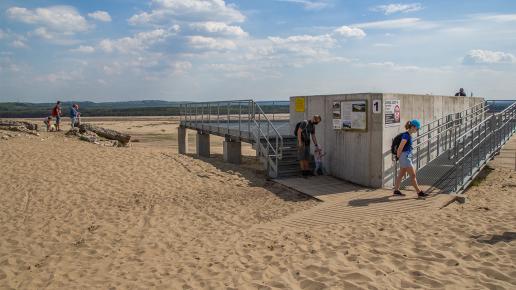
Information for parents with young children
The Błędowska Desert due to the sands itself is on average accessible to wheelchairs, but all viewpoints are adapted for exploring with wheelchairs, so if you are not interested in walking through the open sands, but only admiring the views of them, then you can successfully take the wheelchair. Otherwise, a stretcher or scarf remains. The most interesting and easiest point for people with a wheelchair will certainly be the Rose of the Winds in Keys.
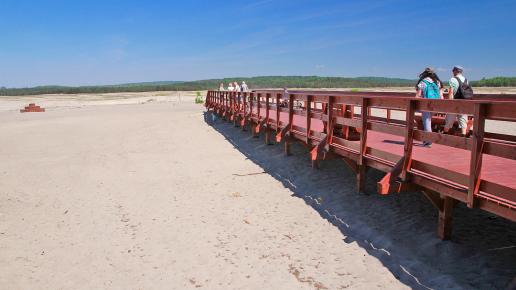
The creation of the Błędów Desert
Legend of the Błędów Desert
If you believe the legend, the Błędowska Desert is the work of the devil, who was so angry at the Olkusz mines that he wanted to cover them with sand from the Baltic Sea. So he flew over Jura with a big sack of sand on his back and headed for Olkusz. Seeing a close target, he slightly lowered the flight and unexpectedly hooked on the high tower of the church in Błędów. By now, you may have guessed that the sack was torn apart, and all the sand flew out and scattered around creating a desert.
All because of the Olkusz mines
If you do not want to, do not believe it, but it is certainly true that it was the Olkusz mines that contributed to the creation of the Błędowska Desert. The uncovering of sands in this area took place in the 13th century, when strongly developed silver mining and metallurgy contributed to the mass clearing of forests in the area and the uncovering of loose glacial sands winding here from as far as the Baltic Sea.
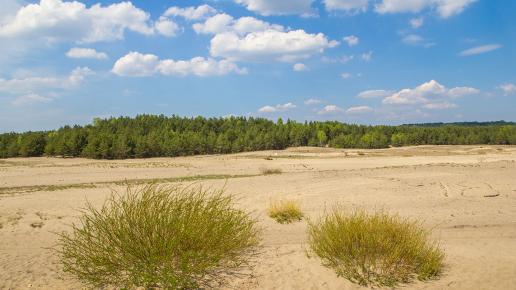
Desert phenomena
At that time, aeolian processes typical of the desert, i.e. wind activity, began here, as a result of which sand dunes were created, the end of which could not be seen. Interestingly, even sandstorms and the mysterious phenomenon of fatamorgana were observed in the Błędowska Desert, as the famous botanist Kazimierz Piech wrote. Naturalists described this place as a wasteland, a sea of sand and a rag of bare earth. That was 100 years ago!
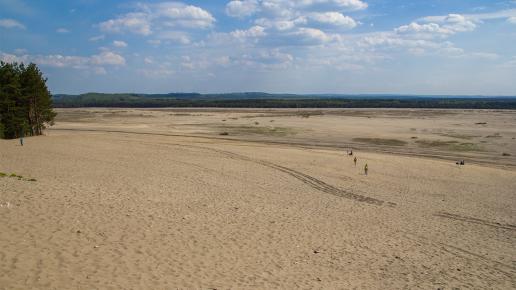
Overgrowth of the Błędów Desert
In the 1960s, the discovered area of sands in the Błędowska Desert was artificially forested, but many species typical of coastal dunes and desert plants still grow here. There was also a natural, gradual overgrowth of exposed sands, i.e. a succession of vegetation. This could have led to the fact that subsequent generations would probably no longer see the Polish desert with their own eyes. Fortunately, for the last few years, intensive cleaning and weeding works have been carried out in the desert, and in this way a lot of discovered sand has appeared again. They are best seen from the Jurassic Key and near the town of Chechło. Only valuable specimens of vegetation, characteristic of sands and desert conditions, were left. Through the middle of the Desert, from west to east, flows the Biała Przemsza River, a deep valley. It divides the Błędowska Desert into the northern part on the side of Chechło and the southern part, to the west of Klucz. The Desert area is covered by the Natura 2000 conservation program. Since 1995, fragments of the Desert have been used ecologically. In 2004, the "Polish Sahara" Association for the promotion and protection of the Błędów Desert was established, which, among others, organized the "Desert Museums" here every summer.
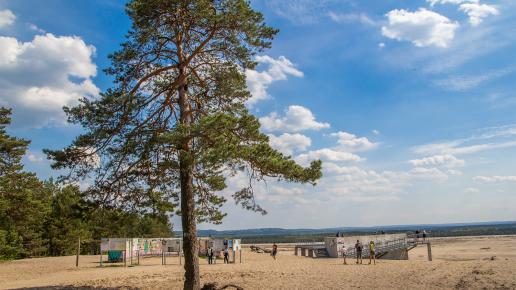
Błędowska Desert - sightseeing and the army
The northern part of the desert is a former military training ground, this area still belongs to the army, but you can only watch parachute jumps here. In this part of the desert, it is forbidden to enter, although there is a viewpoint Dąbrówka, from which you can see beautiful, large stretches of sand and enter them right in the vicinity of the viewpoints. From the platform at Dąbrówka, you can also reach the nearby lookout point at Pustynna Street in Chechle.
The Błędowska Desert can be visited by following the natural didactic path marked in red, which begins at Rudnicka Street in Klucze and runs through the Desert to the backwaters of Biała Przemsza. The yellow Desert Trail will also take you through the Desert, which you can enter on Górna Street in Klucze, near the parking lot in Czubatka. It runs across the entire width of the Desert to Błędów. Horse riding enthusiasts can use the orange Trans-Jurassic Horse Tourism Trail, and cyclists can use the designated marked cycling trails. The northern part of the Błędowska Desert is a military area, as I have already written and there was a ban on entry there for years, but at the Dąbrówka lookout point in Chechle, tourists calmly go out into the open sands. In 1999, NATO maneuvers took place here, and during World War II, the exercises were conducted here by Afrika Korps troops.
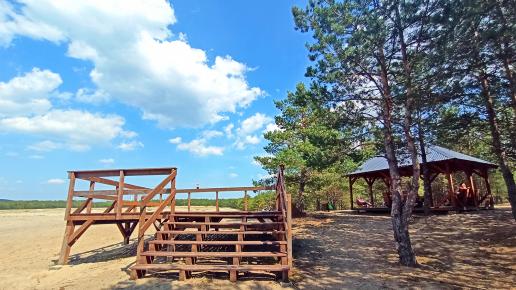
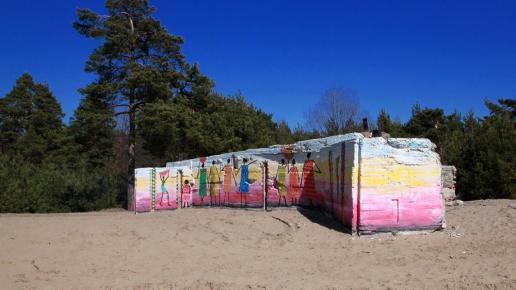
Juromania at the Rose of the Winds
Every autumn, around mid-September, the entire Jurassic Jurassic takes place - a large, multi-day outdoor event, which includes many Jurassic attractions. Also at the Rose of the Winds - a beautiful and popular viewing platform in Klucze, on the sands of the desert, a family picnic usually combined with military attractions takes place.
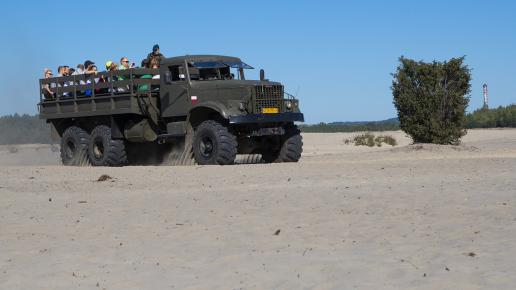
Błędowska Desert
Not everyone knows that the Błędowska Desert became the setting for the popular Polish series "Four Tanks and a Dog". Jerzy Kawalerowicz's famous film "Pharaoh" was also shot here. Today, everyone shoots their films here, perhaps less popular, but also often reflecting the beauty of this surprising, Jurassic corner. We also invite you to watch our film about the Błędowska Desert.
Interesting facts about the Błędów Desert
The desert is such an unusual phenomenon in our country that practically everything that happens on it and what we find on it is a curiosity. Learn some interesting facts about the Polish Sahara!
- The fulgite, or lightning arrow, is an amazing, tubular creature that can be found in the Błędowska Desert. It is created as a result of melting sand from a lightning strike, and we already have something to look for during the next trip to the sands. Such "rods" can be up to 1 meter long and are used to create jewelry. In the past, it was believed that fulgite was a weapon of the Slavic god Perun, hence its other name are perun arrows
- June insect - what does the mouth on the Jura have to do with the red dye? Yes, in the grasses of the Błędowska Desert you will sometimes find a bedbug insect called the Polish June. In the 16th century, this species was bred in Poland in order to obtain a red dye for fabrics (cochineal). Poland was the main supplier of this commodity in Europe! Currently, it is a common dye in the kitchen, but it is no longer obtained from June Polish
- The natural forms that form in the desert are: deflationary pavement, i.e. hard rock crumbs, ripple marks, i.e. wind wrinkles that look like waves, created by the wind, and phytogenic hills, i.e. sand mounds around low plants, which often result in dunes
- During World War II, the area of the Błędów Desert belonged to the Third Reich and the border of the General Government ran through it. It was then a training ground for the Luftwaffe. Various types of bombs were also tested here, it is even said that V1 flying bombs and V2 missiles were tested here
- After World War II, the desert continued to serve as a military training ground, where soldiers of the 6th Pomeranian Airborne Division, the so-called "Red Berets" from Krakow, repeatedly practiced. Parachute training takes place here to this day
- In 1999, NATO aviation units and medical services trained here as part of the "Cooperative Bear '99" maneuvers. At that time, Poland was the host of the "Partnership for Peace" program. These exercises involved, among others, the powerful transport aircraft "Hercules".
- But the first to use the Błędowska Desert for military training purposes were legionnaires from the Legionary Infantry Complementary Battalion of Józef Piłsudski before the battle fought in November 1914 at nearby Krzywopłoty.
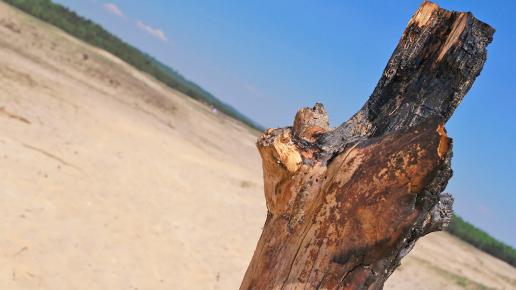
- An unusual attraction, the only one in Poland,with such dimensions
- Hiking trails through the desert
- Convenient and interesting viewpoints
- Outdoor events, e.g. Juromania in September
- Free car parks
- a lot of tourists on warm weekends in the vicinity of viewpoints
Practical information
All day all year round
Admission free
Parking: free at all viewpoints
Viewpoints are accessible for wheelchairs, but the most comfortable will be at the Rose of the Winds
The desert is accessible for dogs
Pustynia Błędowska
Róża Wiatrów
ul. Bolesławska, Klucze
Czubatka, ul. Górna, Klucze
Dąbrówka, ul. Pustynna, Chechło
www.pustyniabledowska.pl/
